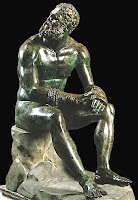As we move into our study of the Romanesque and Gothic Eras, we'll start to discover the nuances between the different cathedral styles and their REGIONAL VARIATIONS.
Block Day will be Sophomore Retreat. Those of you IN CLASS will be able to work on the discussion questions and workbook pages. It is expected that BOTH chapters are read and all discussion questions are prepared for Monday 12-3-12.
Romanesque and Gothic Topics for Discussion
Prepare responses to the following based on your reading of Chapters 17 and 18
What was the political structure of Europe in the Romanesque period?
What effect did pilgrimages and the crusades have on Christendom?
How did intellectual life bloom in the 11th and 12th centuries?
How did Romanesque builders change the early Christian basilica?
Why did mosaics tend to disappear and be replaced by paintings?
The theme in Romanesque church decoration was _____ while the theme in Gothic church decoration was ___.
Where and why was the term Gothic first used?
What was the Age of the Cathedrals?
How are stained glass windows created?
How did the Gothic cathedrals capture the splendor of Paradise on Earth?
Describe ROMANESQUE STYLE using ART vocabulary terms?
Describe GOTHIC STYLE using ART vocabulary terms?
BOTH Romanesque and Gothic cathedrals has regional variations. Explain what they were - perhaps making a chart will be helpful.
Workbook Pages to do: DUE Friday 11-30-12
Chapter 17
Vocabulary words page 163-164, 167
Complete diagram page 165, 168
“Chart” pages at the end of the chapter
Chapter 18
Vocabulary Words page 175, 181
Complete diagram page 178
Complete “Chart” pages at the end of the chapters
We will have a quiz on these chapters Thursday 12-13-12.














































